Strategic Management Report: Flybe Analysis, SAP, CEO, CSO Roles
VerifiedAdded on 2021/07/28
|31
|7599
|358
Report
AI Summary
This strategic management report, prepared for the MSc International Management MBA7013 module, offers a comprehensive analysis of strategic management principles. It begins with an executive summary and organizational context, focusing on the now-defunct airline Flybe. The literature review explores the definition of strategy, strategy as practice (SAP), and the roles of the CEO and CSO in strategic decision-making. The report then delves into key strategic analysis tools, including SWOT, TOWS, Porter's Five Forces, and PESTLE analyses. The core of the report applies these theories to the Flybe case, evaluating the airline's strengths, weaknesses, opportunities, and threats, as well as the impact of external factors. The report concludes with a reflection and a comprehensive bibliography.
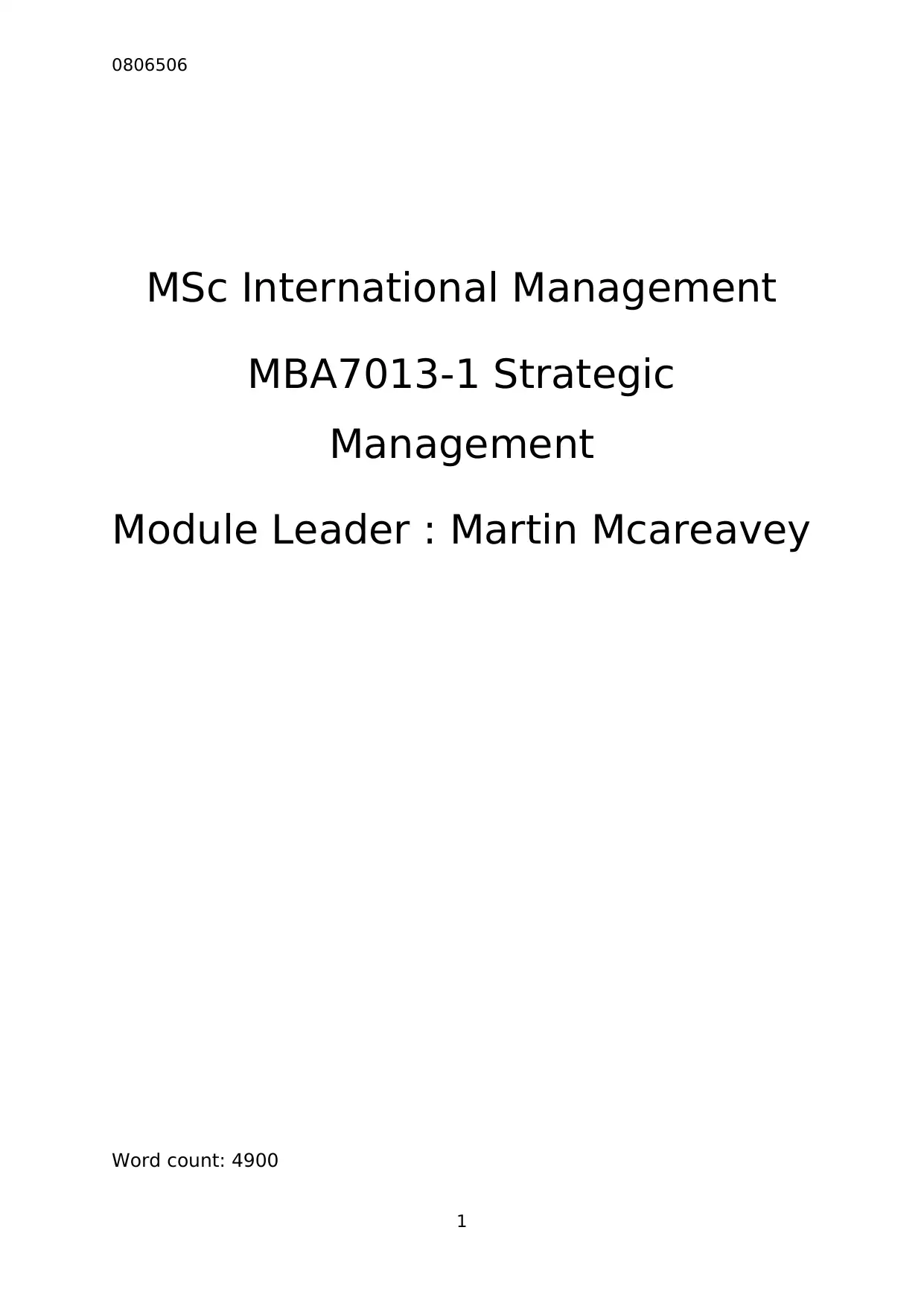
0806506
MSc International Management
MBA7013-1 Strategic
Management
Module Leader : Martin Mcareavey
Word count: 4900
1
MSc International Management
MBA7013-1 Strategic
Management
Module Leader : Martin Mcareavey
Word count: 4900
1
Paraphrase This Document
Need a fresh take? Get an instant paraphrase of this document with our AI Paraphraser
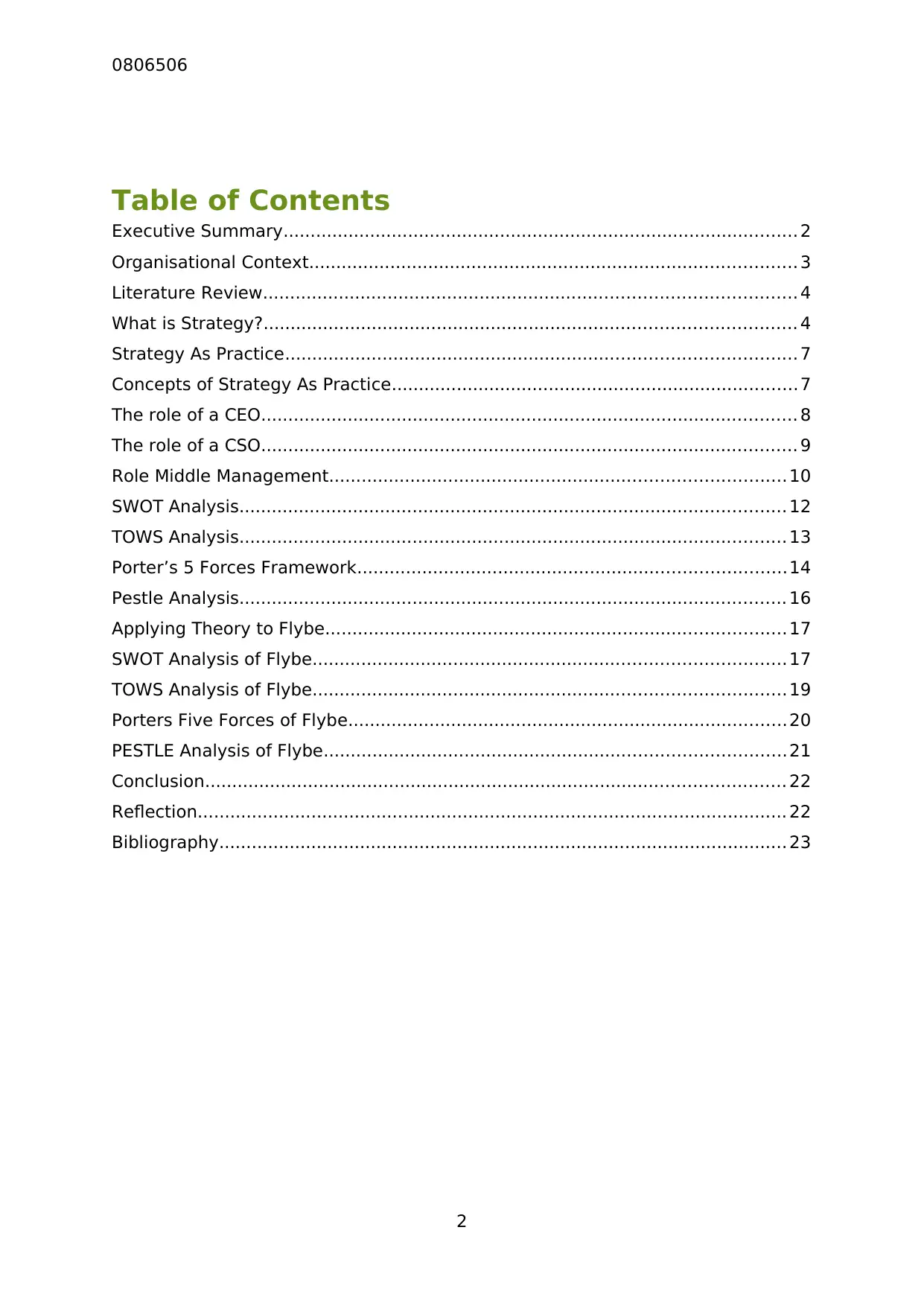
0806506
Table of Contents
Executive Summary............................................................................................... 2
Organisational Context.......................................................................................... 3
Literature Review.................................................................................................. 4
What is Strategy?.................................................................................................. 4
Strategy As Practice.............................................................................................. 7
Concepts of Strategy As Practice...........................................................................7
The role of a CEO................................................................................................... 8
The role of a CSO................................................................................................... 9
Role Middle Management.................................................................................... 10
SWOT Analysis..................................................................................................... 12
TOWS Analysis..................................................................................................... 13
Porter’s 5 Forces Framework...............................................................................14
Pestle Analysis..................................................................................................... 16
Applying Theory to Flybe..................................................................................... 17
SWOT Analysis of Flybe....................................................................................... 17
TOWS Analysis of Flybe....................................................................................... 19
Porters Five Forces of Flybe................................................................................. 20
PESTLE Analysis of Flybe..................................................................................... 21
Conclusion........................................................................................................... 22
Reflection............................................................................................................. 22
Bibliography......................................................................................................... 23
2
Table of Contents
Executive Summary............................................................................................... 2
Organisational Context.......................................................................................... 3
Literature Review.................................................................................................. 4
What is Strategy?.................................................................................................. 4
Strategy As Practice.............................................................................................. 7
Concepts of Strategy As Practice...........................................................................7
The role of a CEO................................................................................................... 8
The role of a CSO................................................................................................... 9
Role Middle Management.................................................................................... 10
SWOT Analysis..................................................................................................... 12
TOWS Analysis..................................................................................................... 13
Porter’s 5 Forces Framework...............................................................................14
Pestle Analysis..................................................................................................... 16
Applying Theory to Flybe..................................................................................... 17
SWOT Analysis of Flybe....................................................................................... 17
TOWS Analysis of Flybe....................................................................................... 19
Porters Five Forces of Flybe................................................................................. 20
PESTLE Analysis of Flybe..................................................................................... 21
Conclusion........................................................................................................... 22
Reflection............................................................................................................. 22
Bibliography......................................................................................................... 23
2
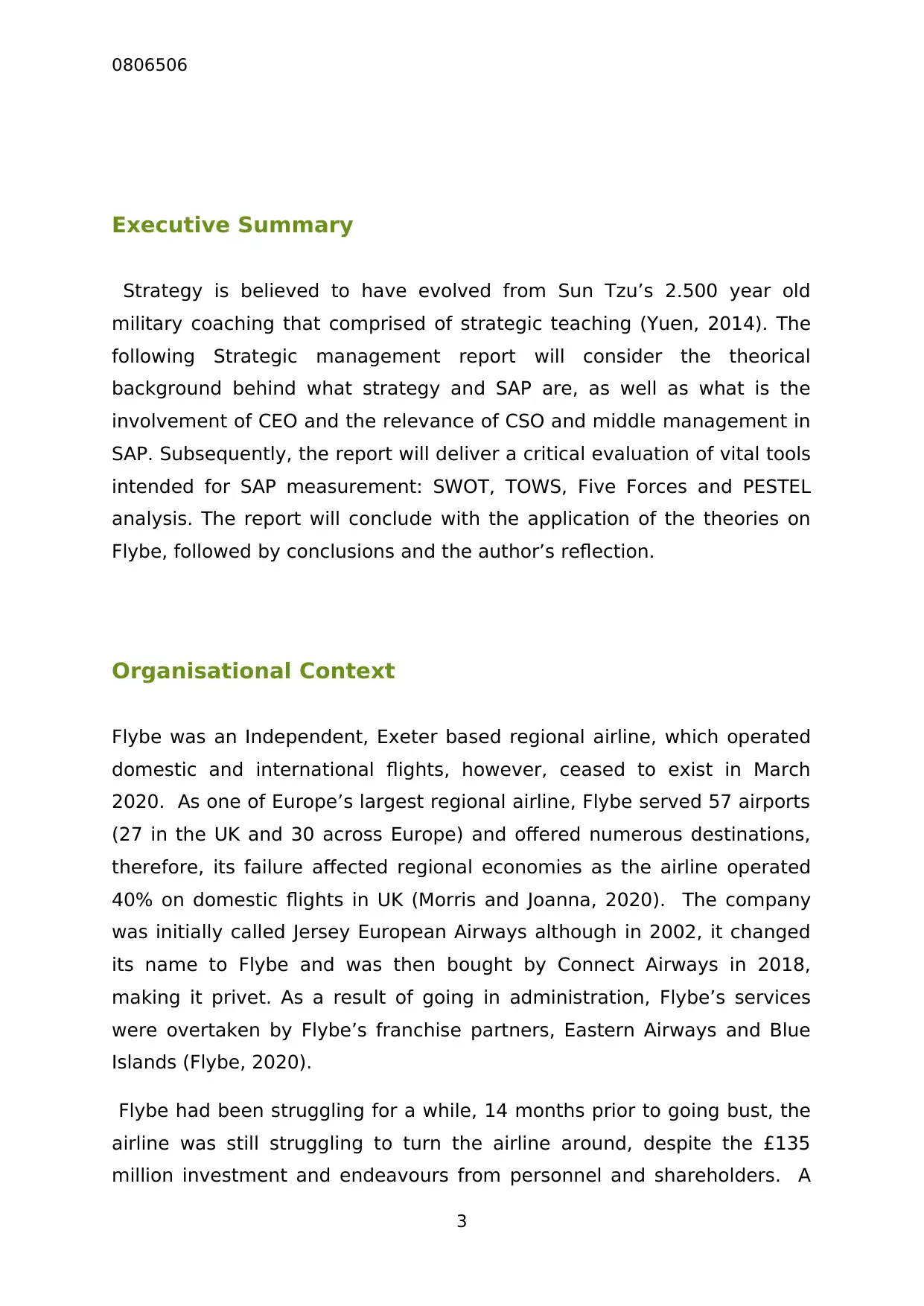
0806506
Executive Summary
Strategy is believed to have evolved from Sun Tzu’s 2.500 year old
military coaching that comprised of strategic teaching (Yuen, 2014). The
following Strategic management report will consider the theorical
background behind what strategy and SAP are, as well as what is the
involvement of CEO and the relevance of CSO and middle management in
SAP. Subsequently, the report will deliver a critical evaluation of vital tools
intended for SAP measurement: SWOT, TOWS, Five Forces and PESTEL
analysis. The report will conclude with the application of the theories on
Flybe, followed by conclusions and the author’s reflection.
Organisational Context
Flybe was an Independent, Exeter based regional airline, which operated
domestic and international flights, however, ceased to exist in March
2020. As one of Europe’s largest regional airline, Flybe served 57 airports
(27 in the UK and 30 across Europe) and offered numerous destinations,
therefore, its failure affected regional economies as the airline operated
40% on domestic flights in UK (Morris and Joanna, 2020). The company
was initially called Jersey European Airways although in 2002, it changed
its name to Flybe and was then bought by Connect Airways in 2018,
making it privet. As a result of going in administration, Flybe’s services
were overtaken by Flybe’s franchise partners, Eastern Airways and Blue
Islands (Flybe, 2020).
Flybe had been struggling for a while, 14 months prior to going bust, the
airline was still struggling to turn the airline around, despite the £135
million investment and endeavours from personnel and shareholders. A
3
Executive Summary
Strategy is believed to have evolved from Sun Tzu’s 2.500 year old
military coaching that comprised of strategic teaching (Yuen, 2014). The
following Strategic management report will consider the theorical
background behind what strategy and SAP are, as well as what is the
involvement of CEO and the relevance of CSO and middle management in
SAP. Subsequently, the report will deliver a critical evaluation of vital tools
intended for SAP measurement: SWOT, TOWS, Five Forces and PESTEL
analysis. The report will conclude with the application of the theories on
Flybe, followed by conclusions and the author’s reflection.
Organisational Context
Flybe was an Independent, Exeter based regional airline, which operated
domestic and international flights, however, ceased to exist in March
2020. As one of Europe’s largest regional airline, Flybe served 57 airports
(27 in the UK and 30 across Europe) and offered numerous destinations,
therefore, its failure affected regional economies as the airline operated
40% on domestic flights in UK (Morris and Joanna, 2020). The company
was initially called Jersey European Airways although in 2002, it changed
its name to Flybe and was then bought by Connect Airways in 2018,
making it privet. As a result of going in administration, Flybe’s services
were overtaken by Flybe’s franchise partners, Eastern Airways and Blue
Islands (Flybe, 2020).
Flybe had been struggling for a while, 14 months prior to going bust, the
airline was still struggling to turn the airline around, despite the £135
million investment and endeavours from personnel and shareholders. A
3
⊘ This is a preview!⊘
Do you want full access?
Subscribe today to unlock all pages.

Trusted by 1+ million students worldwide
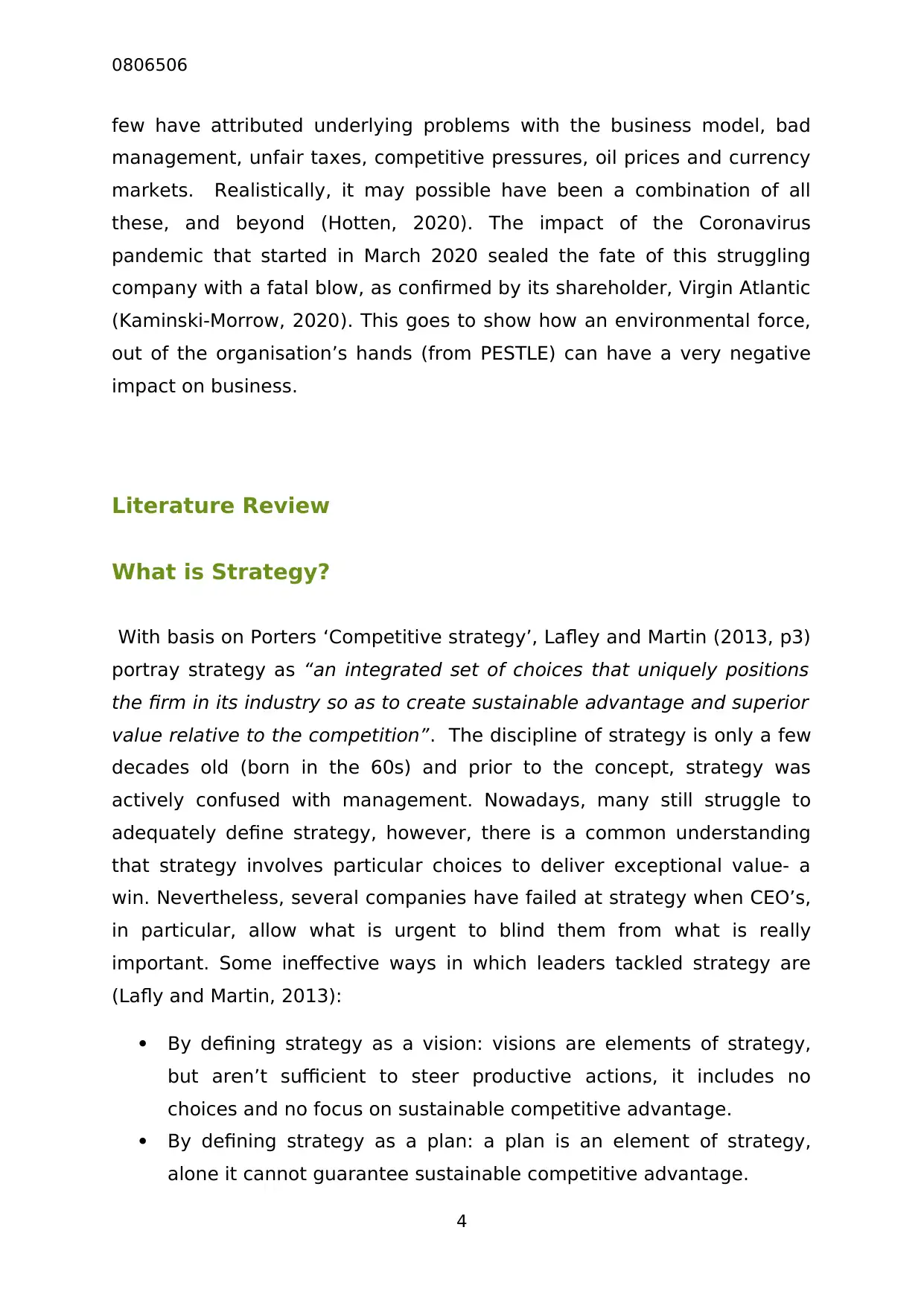
0806506
few have attributed underlying problems with the business model, bad
management, unfair taxes, competitive pressures, oil prices and currency
markets. Realistically, it may possible have been a combination of all
these, and beyond (Hotten, 2020). The impact of the Coronavirus
pandemic that started in March 2020 sealed the fate of this struggling
company with a fatal blow, as confirmed by its shareholder, Virgin Atlantic
(Kaminski-Morrow, 2020). This goes to show how an environmental force,
out of the organisation’s hands (from PESTLE) can have a very negative
impact on business.
Literature Review
What is Strategy?
With basis on Porters ‘Competitive strategy’, Lafley and Martin (2013, p3)
portray strategy as “an integrated set of choices that uniquely positions
the firm in its industry so as to create sustainable advantage and superior
value relative to the competition”. The discipline of strategy is only a few
decades old (born in the 60s) and prior to the concept, strategy was
actively confused with management. Nowadays, many still struggle to
adequately define strategy, however, there is a common understanding
that strategy involves particular choices to deliver exceptional value- a
win. Nevertheless, several companies have failed at strategy when CEO’s,
in particular, allow what is urgent to blind them from what is really
important. Some ineffective ways in which leaders tackled strategy are
(Lafly and Martin, 2013):
By defining strategy as a vision: visions are elements of strategy,
but aren’t sufficient to steer productive actions, it includes no
choices and no focus on sustainable competitive advantage.
By defining strategy as a plan: a plan is an element of strategy,
alone it cannot guarantee sustainable competitive advantage.
4
few have attributed underlying problems with the business model, bad
management, unfair taxes, competitive pressures, oil prices and currency
markets. Realistically, it may possible have been a combination of all
these, and beyond (Hotten, 2020). The impact of the Coronavirus
pandemic that started in March 2020 sealed the fate of this struggling
company with a fatal blow, as confirmed by its shareholder, Virgin Atlantic
(Kaminski-Morrow, 2020). This goes to show how an environmental force,
out of the organisation’s hands (from PESTLE) can have a very negative
impact on business.
Literature Review
What is Strategy?
With basis on Porters ‘Competitive strategy’, Lafley and Martin (2013, p3)
portray strategy as “an integrated set of choices that uniquely positions
the firm in its industry so as to create sustainable advantage and superior
value relative to the competition”. The discipline of strategy is only a few
decades old (born in the 60s) and prior to the concept, strategy was
actively confused with management. Nowadays, many still struggle to
adequately define strategy, however, there is a common understanding
that strategy involves particular choices to deliver exceptional value- a
win. Nevertheless, several companies have failed at strategy when CEO’s,
in particular, allow what is urgent to blind them from what is really
important. Some ineffective ways in which leaders tackled strategy are
(Lafly and Martin, 2013):
By defining strategy as a vision: visions are elements of strategy,
but aren’t sufficient to steer productive actions, it includes no
choices and no focus on sustainable competitive advantage.
By defining strategy as a plan: a plan is an element of strategy,
alone it cannot guarantee sustainable competitive advantage.
4
Paraphrase This Document
Need a fresh take? Get an instant paraphrase of this document with our AI Paraphraser
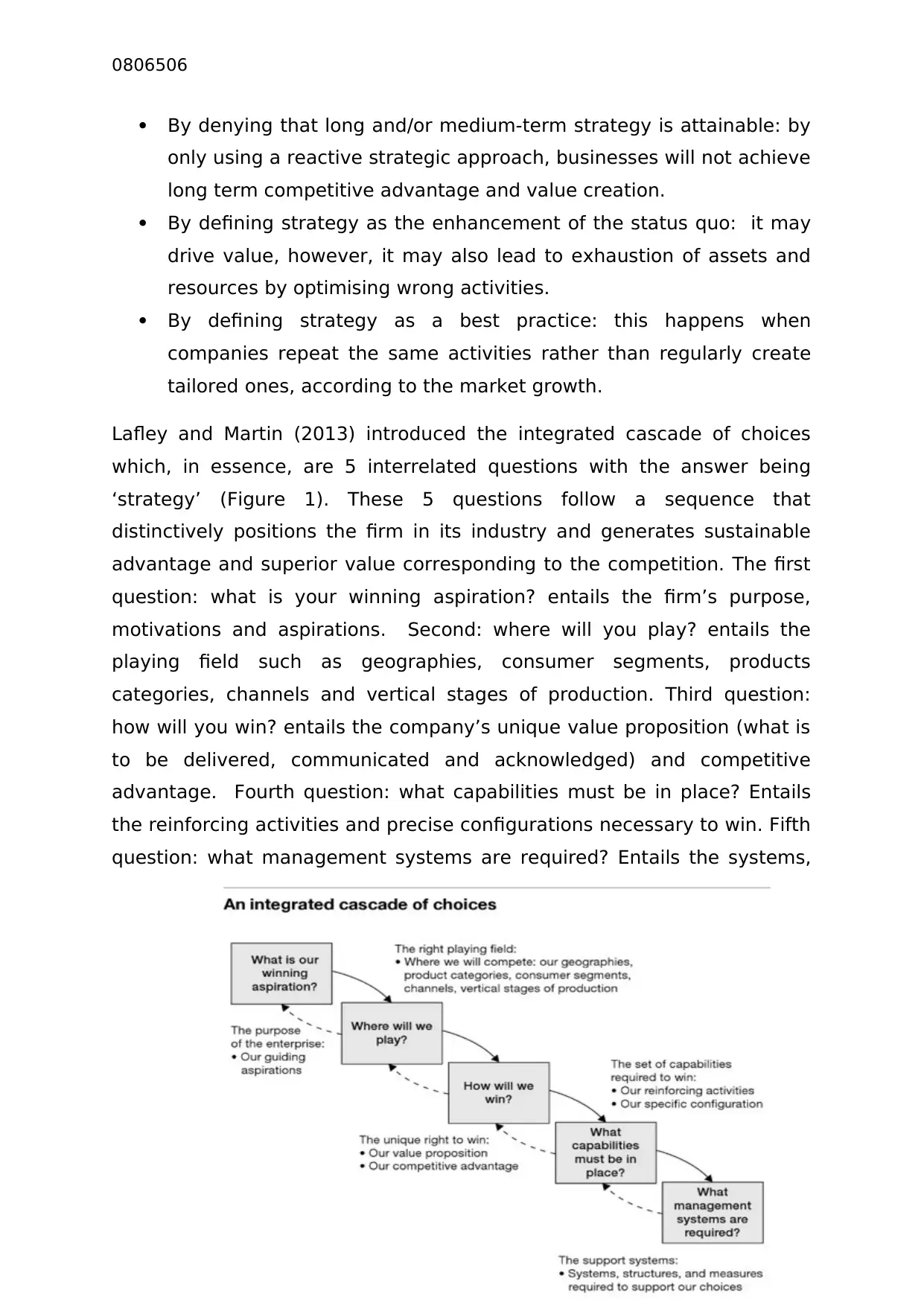
0806506
By denying that long and/or medium-term strategy is attainable: by
only using a reactive strategic approach, businesses will not achieve
long term competitive advantage and value creation.
By defining strategy as the enhancement of the status quo: it may
drive value, however, it may also lead to exhaustion of assets and
resources by optimising wrong activities.
By defining strategy as a best practice: this happens when
companies repeat the same activities rather than regularly create
tailored ones, according to the market growth.
Lafley and Martin (2013) introduced the integrated cascade of choices
which, in essence, are 5 interrelated questions with the answer being
‘strategy’ (Figure 1). These 5 questions follow a sequence that
distinctively positions the firm in its industry and generates sustainable
advantage and superior value corresponding to the competition. The first
question: what is your winning aspiration? entails the firm’s purpose,
motivations and aspirations. Second: where will you play? entails the
playing field such as geographies, consumer segments, products
categories, channels and vertical stages of production. Third question:
how will you win? entails the company’s unique value proposition (what is
to be delivered, communicated and acknowledged) and competitive
advantage. Fourth question: what capabilities must be in place? Entails
the reinforcing activities and precise configurations necessary to win. Fifth
question: what management systems are required? Entails the systems,
5
By denying that long and/or medium-term strategy is attainable: by
only using a reactive strategic approach, businesses will not achieve
long term competitive advantage and value creation.
By defining strategy as the enhancement of the status quo: it may
drive value, however, it may also lead to exhaustion of assets and
resources by optimising wrong activities.
By defining strategy as a best practice: this happens when
companies repeat the same activities rather than regularly create
tailored ones, according to the market growth.
Lafley and Martin (2013) introduced the integrated cascade of choices
which, in essence, are 5 interrelated questions with the answer being
‘strategy’ (Figure 1). These 5 questions follow a sequence that
distinctively positions the firm in its industry and generates sustainable
advantage and superior value corresponding to the competition. The first
question: what is your winning aspiration? entails the firm’s purpose,
motivations and aspirations. Second: where will you play? entails the
playing field such as geographies, consumer segments, products
categories, channels and vertical stages of production. Third question:
how will you win? entails the company’s unique value proposition (what is
to be delivered, communicated and acknowledged) and competitive
advantage. Fourth question: what capabilities must be in place? Entails
the reinforcing activities and precise configurations necessary to win. Fifth
question: what management systems are required? Entails the systems,
5
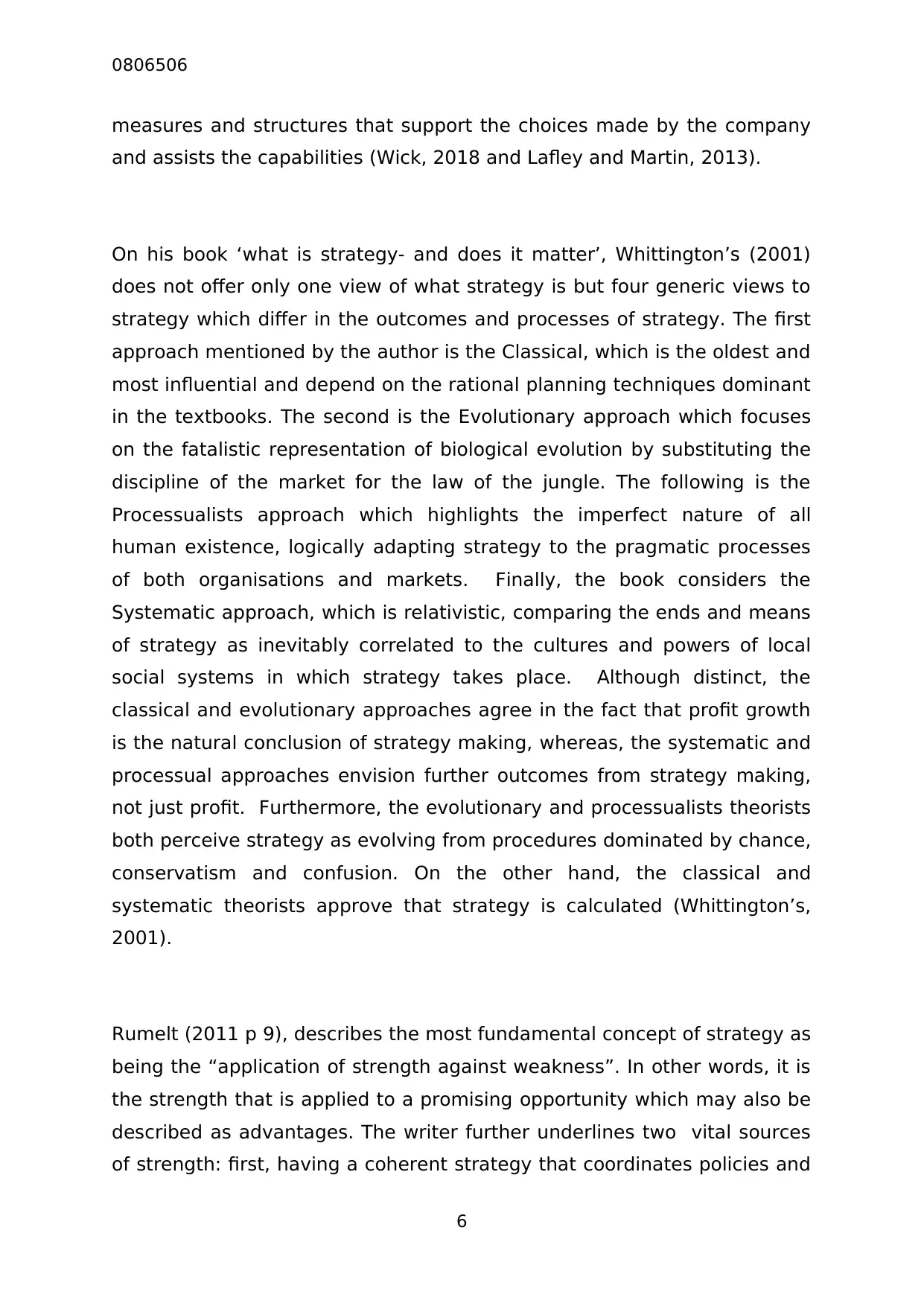
0806506
measures and structures that support the choices made by the company
and assists the capabilities (Wick, 2018 and Lafley and Martin, 2013).
On his book ‘what is strategy- and does it matter’, Whittington’s (2001)
does not offer only one view of what strategy is but four generic views to
strategy which differ in the outcomes and processes of strategy. The first
approach mentioned by the author is the Classical, which is the oldest and
most influential and depend on the rational planning techniques dominant
in the textbooks. The second is the Evolutionary approach which focuses
on the fatalistic representation of biological evolution by substituting the
discipline of the market for the law of the jungle. The following is the
Processualists approach which highlights the imperfect nature of all
human existence, logically adapting strategy to the pragmatic processes
of both organisations and markets. Finally, the book considers the
Systematic approach, which is relativistic, comparing the ends and means
of strategy as inevitably correlated to the cultures and powers of local
social systems in which strategy takes place. Although distinct, the
classical and evolutionary approaches agree in the fact that profit growth
is the natural conclusion of strategy making, whereas, the systematic and
processual approaches envision further outcomes from strategy making,
not just profit. Furthermore, the evolutionary and processualists theorists
both perceive strategy as evolving from procedures dominated by chance,
conservatism and confusion. On the other hand, the classical and
systematic theorists approve that strategy is calculated (Whittington’s,
2001).
Rumelt (2011 p 9), describes the most fundamental concept of strategy as
being the “application of strength against weakness”. In other words, it is
the strength that is applied to a promising opportunity which may also be
described as advantages. The writer further underlines two vital sources
of strength: first, having a coherent strategy that coordinates policies and
6
measures and structures that support the choices made by the company
and assists the capabilities (Wick, 2018 and Lafley and Martin, 2013).
On his book ‘what is strategy- and does it matter’, Whittington’s (2001)
does not offer only one view of what strategy is but four generic views to
strategy which differ in the outcomes and processes of strategy. The first
approach mentioned by the author is the Classical, which is the oldest and
most influential and depend on the rational planning techniques dominant
in the textbooks. The second is the Evolutionary approach which focuses
on the fatalistic representation of biological evolution by substituting the
discipline of the market for the law of the jungle. The following is the
Processualists approach which highlights the imperfect nature of all
human existence, logically adapting strategy to the pragmatic processes
of both organisations and markets. Finally, the book considers the
Systematic approach, which is relativistic, comparing the ends and means
of strategy as inevitably correlated to the cultures and powers of local
social systems in which strategy takes place. Although distinct, the
classical and evolutionary approaches agree in the fact that profit growth
is the natural conclusion of strategy making, whereas, the systematic and
processual approaches envision further outcomes from strategy making,
not just profit. Furthermore, the evolutionary and processualists theorists
both perceive strategy as evolving from procedures dominated by chance,
conservatism and confusion. On the other hand, the classical and
systematic theorists approve that strategy is calculated (Whittington’s,
2001).
Rumelt (2011 p 9), describes the most fundamental concept of strategy as
being the “application of strength against weakness”. In other words, it is
the strength that is applied to a promising opportunity which may also be
described as advantages. The writer further underlines two vital sources
of strength: first, having a coherent strategy that coordinates policies and
6
⊘ This is a preview!⊘
Do you want full access?
Subscribe today to unlock all pages.

Trusted by 1+ million students worldwide
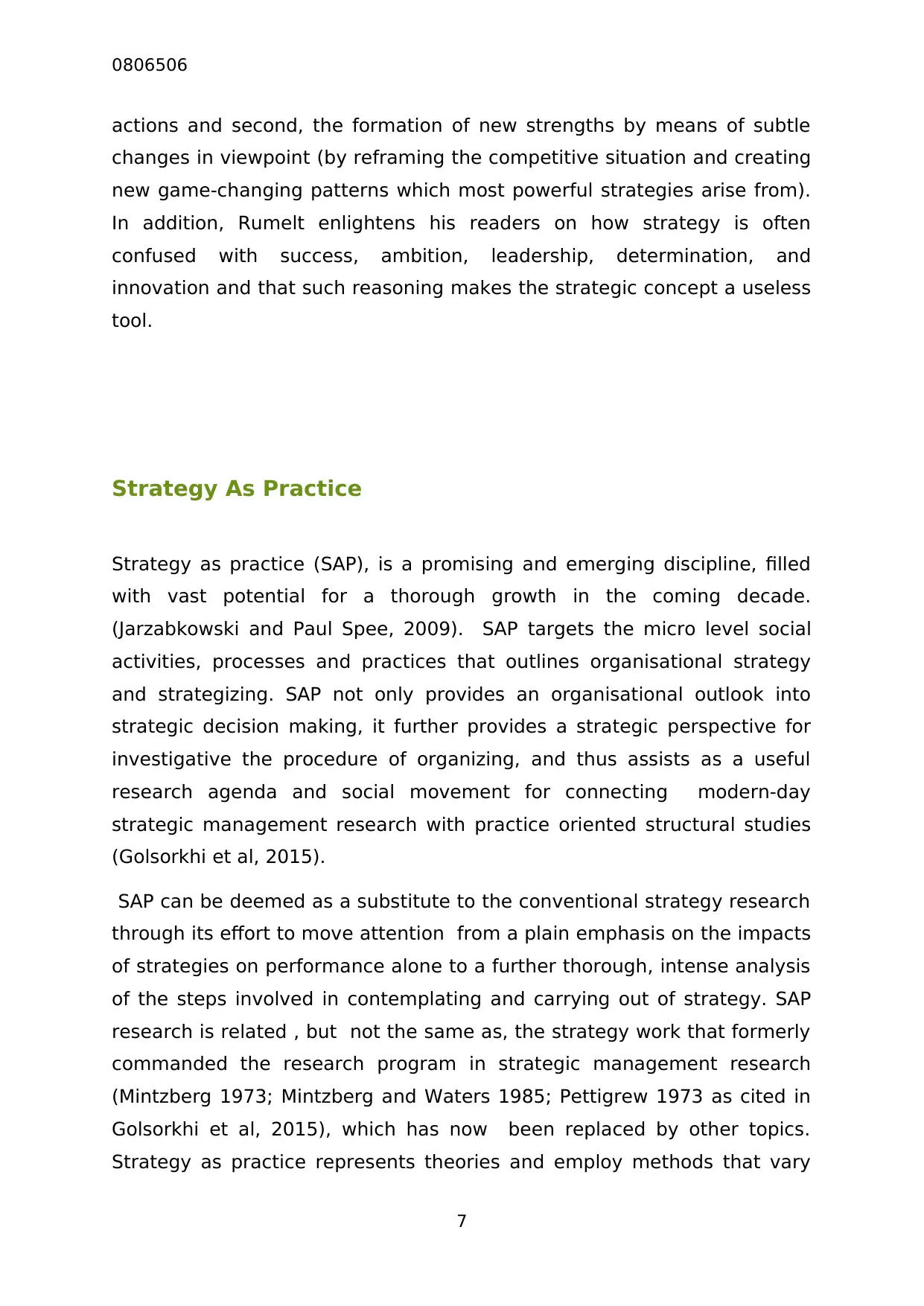
0806506
actions and second, the formation of new strengths by means of subtle
changes in viewpoint (by reframing the competitive situation and creating
new game-changing patterns which most powerful strategies arise from).
In addition, Rumelt enlightens his readers on how strategy is often
confused with success, ambition, leadership, determination, and
innovation and that such reasoning makes the strategic concept a useless
tool.
Strategy As Practice
Strategy as practice (SAP), is a promising and emerging discipline, filled
with vast potential for a thorough growth in the coming decade.
(Jarzabkowski and Paul Spee, 2009). SAP targets the micro level social
activities, processes and practices that outlines organisational strategy
and strategizing. SAP not only provides an organisational outlook into
strategic decision making, it further provides a strategic perspective for
investigative the procedure of organizing, and thus assists as a useful
research agenda and social movement for connecting modern-day
strategic management research with practice oriented structural studies
(Golsorkhi et al, 2015).
SAP can be deemed as a substitute to the conventional strategy research
through its effort to move attention from a plain emphasis on the impacts
of strategies on performance alone to a further thorough, intense analysis
of the steps involved in contemplating and carrying out of strategy. SAP
research is related , but not the same as, the strategy work that formerly
commanded the research program in strategic management research
(Mintzberg 1973; Mintzberg and Waters 1985; Pettigrew 1973 as cited in
Golsorkhi et al, 2015), which has now been replaced by other topics.
Strategy as practice represents theories and employ methods that vary
7
actions and second, the formation of new strengths by means of subtle
changes in viewpoint (by reframing the competitive situation and creating
new game-changing patterns which most powerful strategies arise from).
In addition, Rumelt enlightens his readers on how strategy is often
confused with success, ambition, leadership, determination, and
innovation and that such reasoning makes the strategic concept a useless
tool.
Strategy As Practice
Strategy as practice (SAP), is a promising and emerging discipline, filled
with vast potential for a thorough growth in the coming decade.
(Jarzabkowski and Paul Spee, 2009). SAP targets the micro level social
activities, processes and practices that outlines organisational strategy
and strategizing. SAP not only provides an organisational outlook into
strategic decision making, it further provides a strategic perspective for
investigative the procedure of organizing, and thus assists as a useful
research agenda and social movement for connecting modern-day
strategic management research with practice oriented structural studies
(Golsorkhi et al, 2015).
SAP can be deemed as a substitute to the conventional strategy research
through its effort to move attention from a plain emphasis on the impacts
of strategies on performance alone to a further thorough, intense analysis
of the steps involved in contemplating and carrying out of strategy. SAP
research is related , but not the same as, the strategy work that formerly
commanded the research program in strategic management research
(Mintzberg 1973; Mintzberg and Waters 1985; Pettigrew 1973 as cited in
Golsorkhi et al, 2015), which has now been replaced by other topics.
Strategy as practice represents theories and employ methods that vary
7
Paraphrase This Document
Need a fresh take? Get an instant paraphrase of this document with our AI Paraphraser
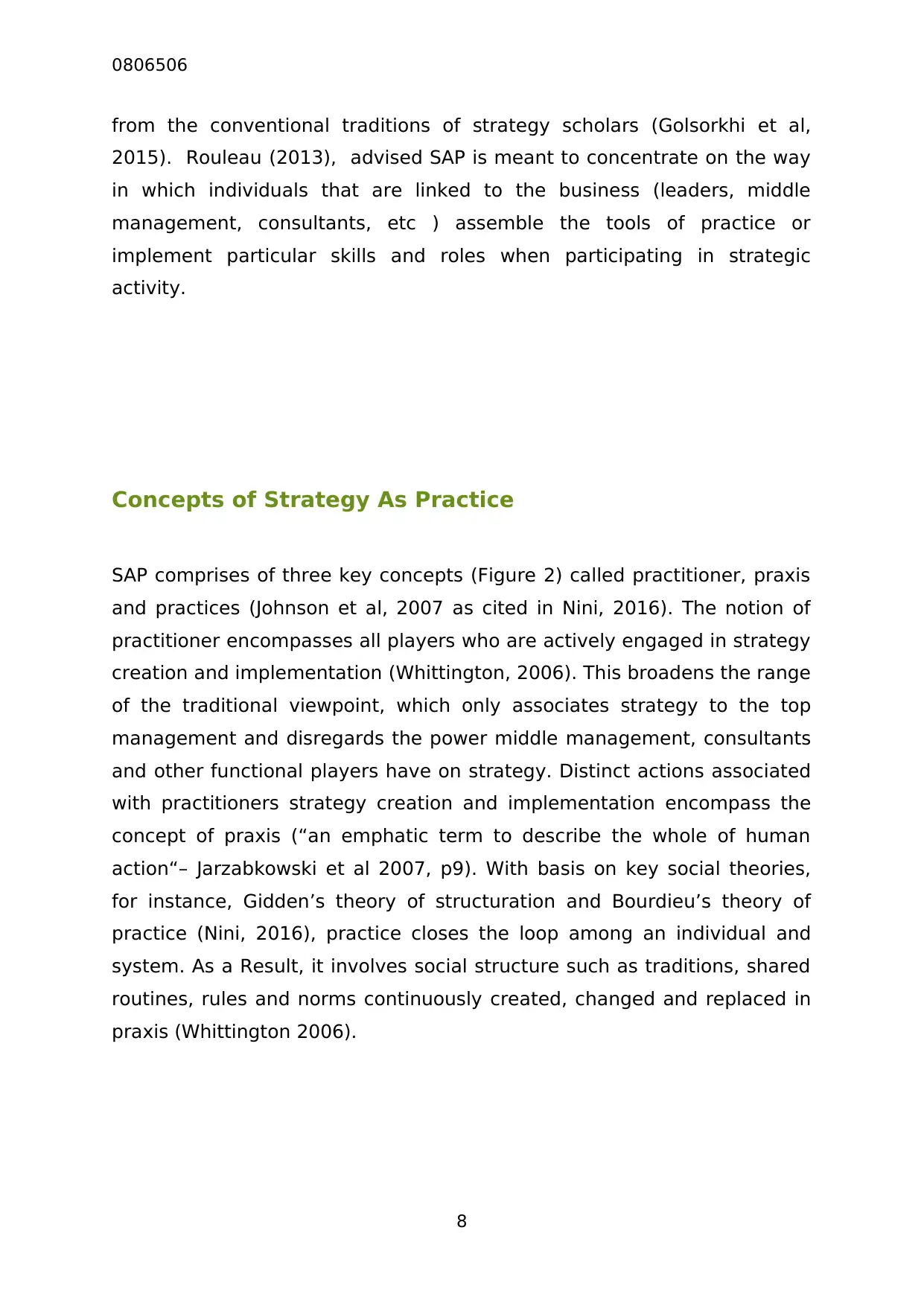
0806506
from the conventional traditions of strategy scholars (Golsorkhi et al,
2015). Rouleau (2013), advised SAP is meant to concentrate on the way
in which individuals that are linked to the business (leaders, middle
management, consultants, etc ) assemble the tools of practice or
implement particular skills and roles when participating in strategic
activity.
Concepts of Strategy As Practice
SAP comprises of three key concepts (Figure 2) called practitioner, praxis
and practices (Johnson et al, 2007 as cited in Nini, 2016). The notion of
practitioner encompasses all players who are actively engaged in strategy
creation and implementation (Whittington, 2006). This broadens the range
of the traditional viewpoint, which only associates strategy to the top
management and disregards the power middle management, consultants
and other functional players have on strategy. Distinct actions associated
with practitioners strategy creation and implementation encompass the
concept of praxis (“an emphatic term to describe the whole of human
action“– Jarzabkowski et al 2007, p9). With basis on key social theories,
for instance, Gidden’s theory of structuration and Bourdieu’s theory of
practice (Nini, 2016), practice closes the loop among an individual and
system. As a Result, it involves social structure such as traditions, shared
routines, rules and norms continuously created, changed and replaced in
praxis (Whittington 2006).
8
from the conventional traditions of strategy scholars (Golsorkhi et al,
2015). Rouleau (2013), advised SAP is meant to concentrate on the way
in which individuals that are linked to the business (leaders, middle
management, consultants, etc ) assemble the tools of practice or
implement particular skills and roles when participating in strategic
activity.
Concepts of Strategy As Practice
SAP comprises of three key concepts (Figure 2) called practitioner, praxis
and practices (Johnson et al, 2007 as cited in Nini, 2016). The notion of
practitioner encompasses all players who are actively engaged in strategy
creation and implementation (Whittington, 2006). This broadens the range
of the traditional viewpoint, which only associates strategy to the top
management and disregards the power middle management, consultants
and other functional players have on strategy. Distinct actions associated
with practitioners strategy creation and implementation encompass the
concept of praxis (“an emphatic term to describe the whole of human
action“– Jarzabkowski et al 2007, p9). With basis on key social theories,
for instance, Gidden’s theory of structuration and Bourdieu’s theory of
practice (Nini, 2016), practice closes the loop among an individual and
system. As a Result, it involves social structure such as traditions, shared
routines, rules and norms continuously created, changed and replaced in
praxis (Whittington 2006).
8
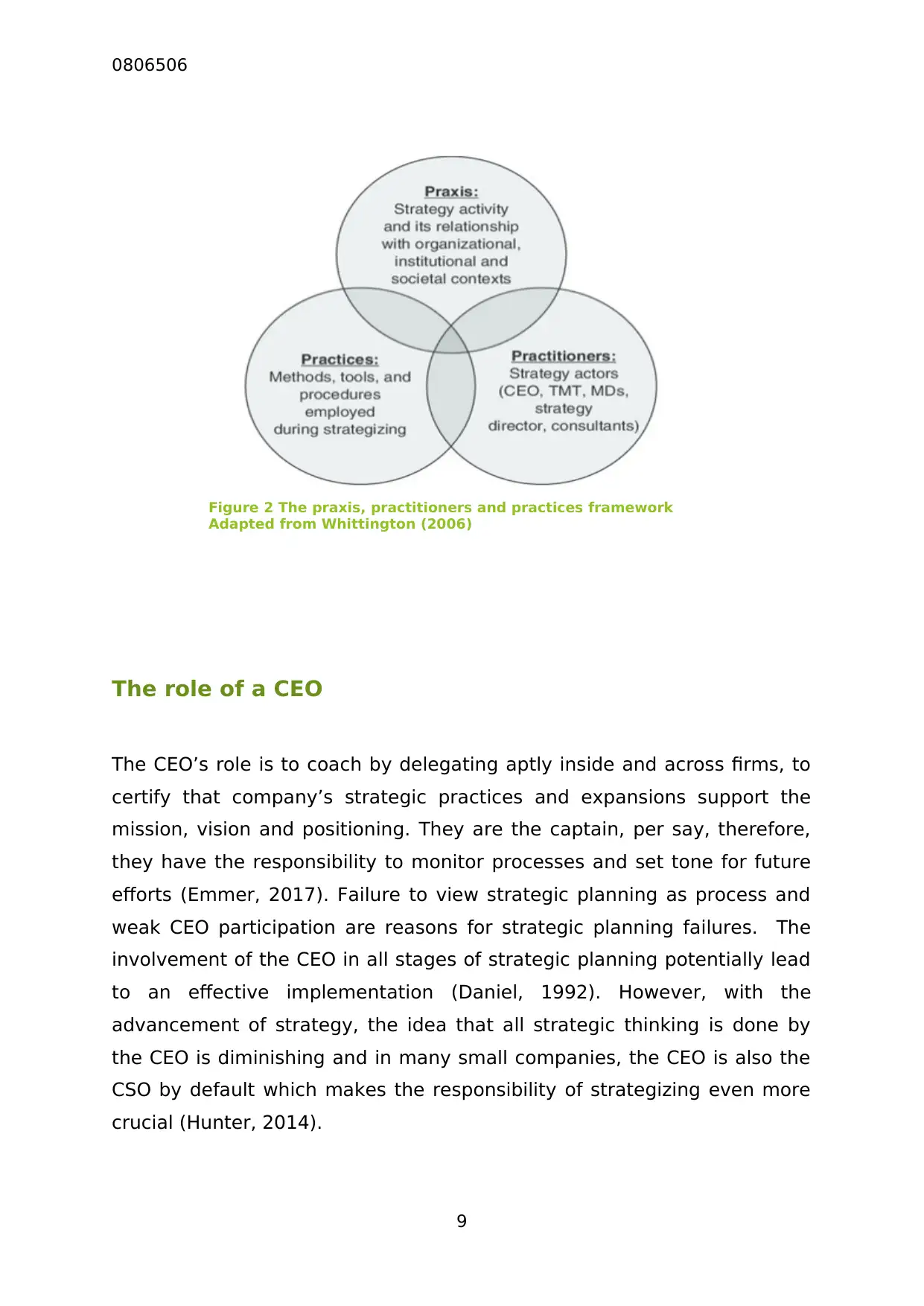
0806506
The role of a CEO
The CEO’s role is to coach by delegating aptly inside and across firms, to
certify that company’s strategic practices and expansions support the
mission, vision and positioning. They are the captain, per say, therefore,
they have the responsibility to monitor processes and set tone for future
efforts (Emmer, 2017). Failure to view strategic planning as process and
weak CEO participation are reasons for strategic planning failures. The
involvement of the CEO in all stages of strategic planning potentially lead
to an effective implementation (Daniel, 1992). However, with the
advancement of strategy, the idea that all strategic thinking is done by
the CEO is diminishing and in many small companies, the CEO is also the
CSO by default which makes the responsibility of strategizing even more
crucial (Hunter, 2014).
9
Figure 2 The praxis, practitioners and practices framework
Adapted from Whittington (2006)
The role of a CEO
The CEO’s role is to coach by delegating aptly inside and across firms, to
certify that company’s strategic practices and expansions support the
mission, vision and positioning. They are the captain, per say, therefore,
they have the responsibility to monitor processes and set tone for future
efforts (Emmer, 2017). Failure to view strategic planning as process and
weak CEO participation are reasons for strategic planning failures. The
involvement of the CEO in all stages of strategic planning potentially lead
to an effective implementation (Daniel, 1992). However, with the
advancement of strategy, the idea that all strategic thinking is done by
the CEO is diminishing and in many small companies, the CEO is also the
CSO by default which makes the responsibility of strategizing even more
crucial (Hunter, 2014).
9
Figure 2 The praxis, practitioners and practices framework
Adapted from Whittington (2006)
⊘ This is a preview!⊘
Do you want full access?
Subscribe today to unlock all pages.

Trusted by 1+ million students worldwide
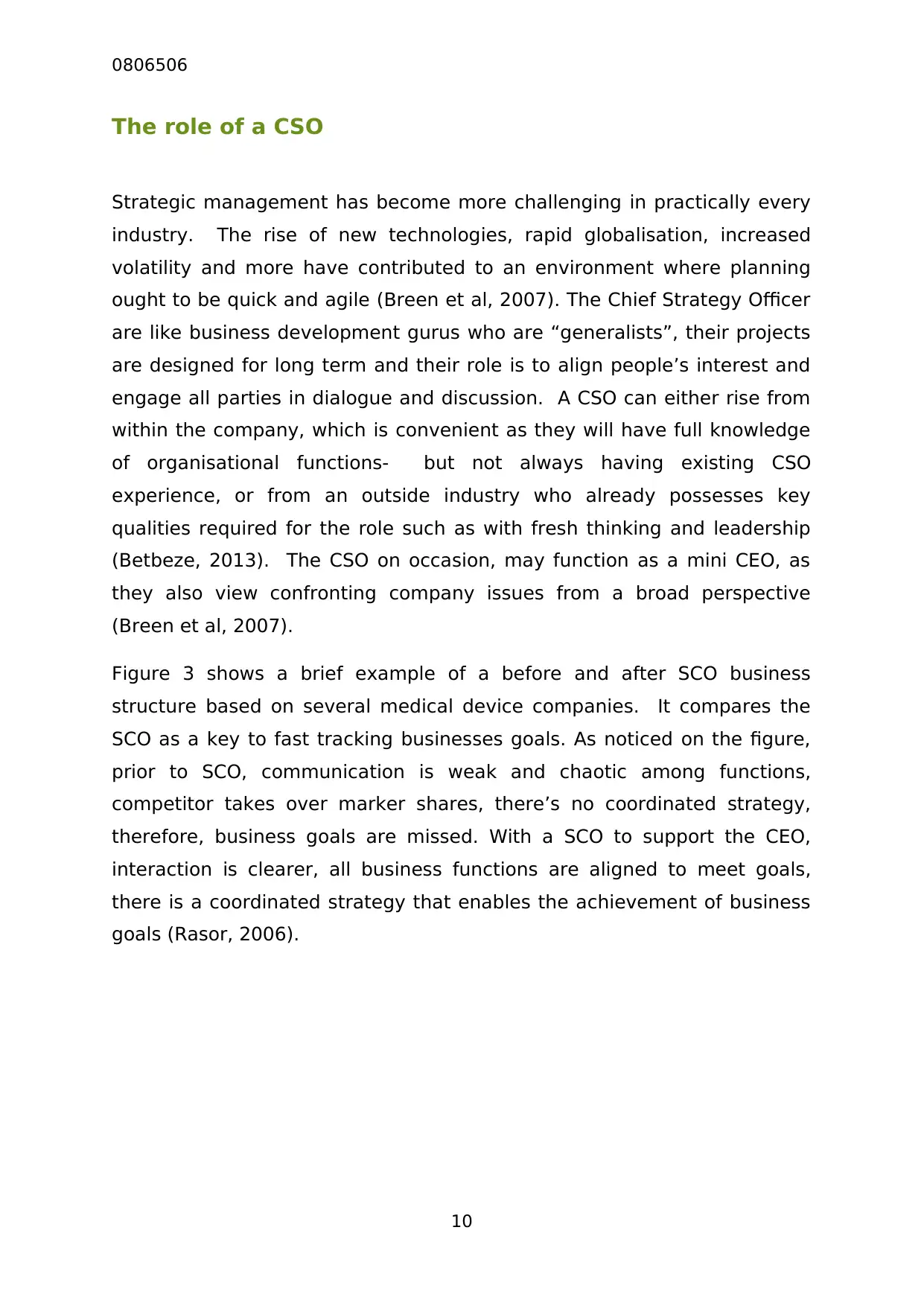
0806506
The role of a CSO
Strategic management has become more challenging in practically every
industry. The rise of new technologies, rapid globalisation, increased
volatility and more have contributed to an environment where planning
ought to be quick and agile (Breen et al, 2007). The Chief Strategy Officer
are like business development gurus who are “generalists”, their projects
are designed for long term and their role is to align people’s interest and
engage all parties in dialogue and discussion. A CSO can either rise from
within the company, which is convenient as they will have full knowledge
of organisational functions- but not always having existing CSO
experience, or from an outside industry who already possesses key
qualities required for the role such as with fresh thinking and leadership
(Betbeze, 2013). The CSO on occasion, may function as a mini CEO, as
they also view confronting company issues from a broad perspective
(Breen et al, 2007).
Figure 3 shows a brief example of a before and after SCO business
structure based on several medical device companies. It compares the
SCO as a key to fast tracking businesses goals. As noticed on the figure,
prior to SCO, communication is weak and chaotic among functions,
competitor takes over marker shares, there’s no coordinated strategy,
therefore, business goals are missed. With a SCO to support the CEO,
interaction is clearer, all business functions are aligned to meet goals,
there is a coordinated strategy that enables the achievement of business
goals (Rasor, 2006).
10
The role of a CSO
Strategic management has become more challenging in practically every
industry. The rise of new technologies, rapid globalisation, increased
volatility and more have contributed to an environment where planning
ought to be quick and agile (Breen et al, 2007). The Chief Strategy Officer
are like business development gurus who are “generalists”, their projects
are designed for long term and their role is to align people’s interest and
engage all parties in dialogue and discussion. A CSO can either rise from
within the company, which is convenient as they will have full knowledge
of organisational functions- but not always having existing CSO
experience, or from an outside industry who already possesses key
qualities required for the role such as with fresh thinking and leadership
(Betbeze, 2013). The CSO on occasion, may function as a mini CEO, as
they also view confronting company issues from a broad perspective
(Breen et al, 2007).
Figure 3 shows a brief example of a before and after SCO business
structure based on several medical device companies. It compares the
SCO as a key to fast tracking businesses goals. As noticed on the figure,
prior to SCO, communication is weak and chaotic among functions,
competitor takes over marker shares, there’s no coordinated strategy,
therefore, business goals are missed. With a SCO to support the CEO,
interaction is clearer, all business functions are aligned to meet goals,
there is a coordinated strategy that enables the achievement of business
goals (Rasor, 2006).
10
Paraphrase This Document
Need a fresh take? Get an instant paraphrase of this document with our AI Paraphraser
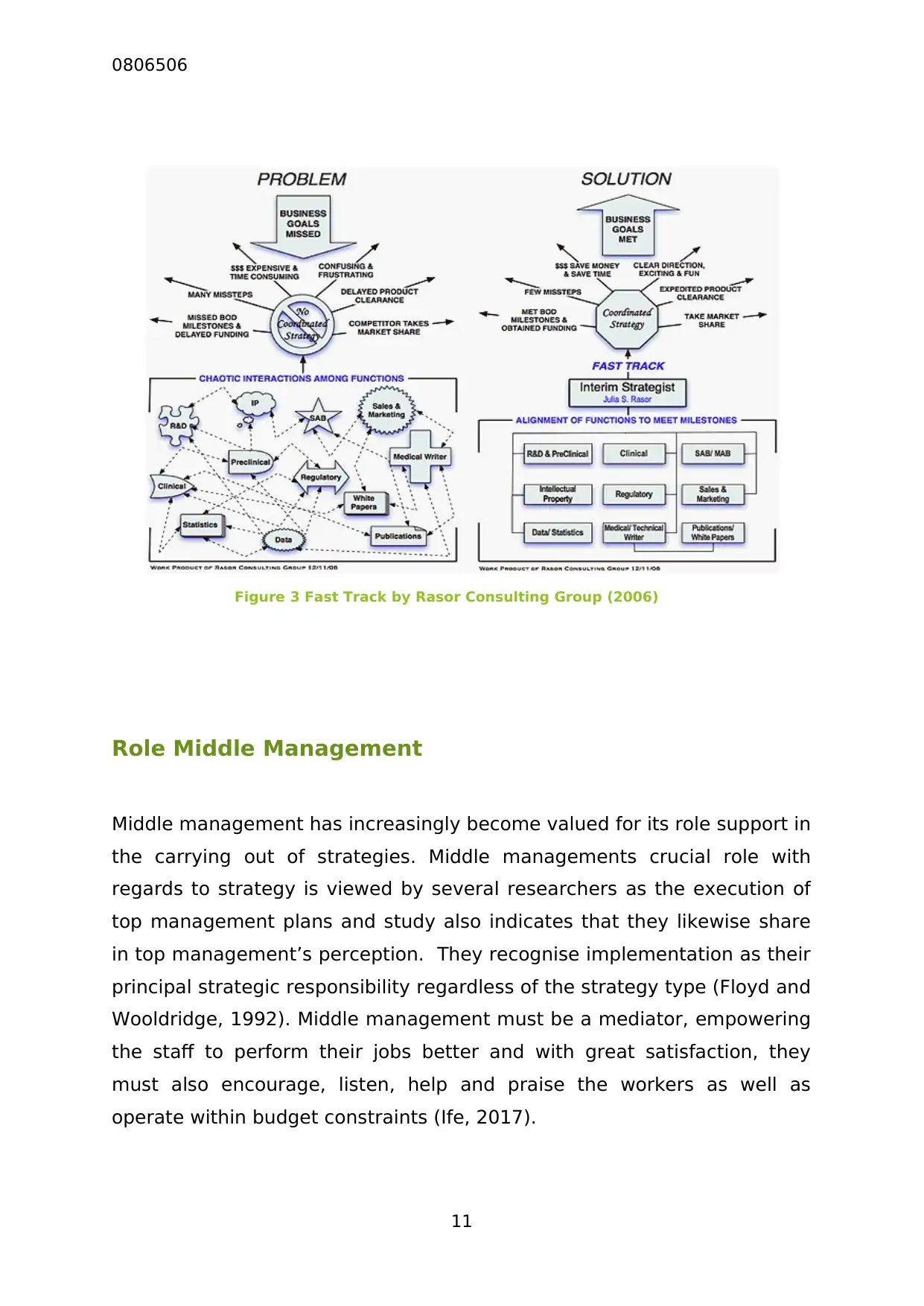
0806506
Role Middle Management
Middle management has increasingly become valued for its role support in
the carrying out of strategies. Middle managements crucial role with
regards to strategy is viewed by several researchers as the execution of
top management plans and study also indicates that they likewise share
in top management’s perception. They recognise implementation as their
principal strategic responsibility regardless of the strategy type (Floyd and
Wooldridge, 1992). Middle management must be a mediator, empowering
the staff to perform their jobs better and with great satisfaction, they
must also encourage, listen, help and praise the workers as well as
operate within budget constraints (Ife, 2017).
11
Figure 3 Fast Track by Rasor Consulting Group (2006)
Role Middle Management
Middle management has increasingly become valued for its role support in
the carrying out of strategies. Middle managements crucial role with
regards to strategy is viewed by several researchers as the execution of
top management plans and study also indicates that they likewise share
in top management’s perception. They recognise implementation as their
principal strategic responsibility regardless of the strategy type (Floyd and
Wooldridge, 1992). Middle management must be a mediator, empowering
the staff to perform their jobs better and with great satisfaction, they
must also encourage, listen, help and praise the workers as well as
operate within budget constraints (Ife, 2017).
11
Figure 3 Fast Track by Rasor Consulting Group (2006)
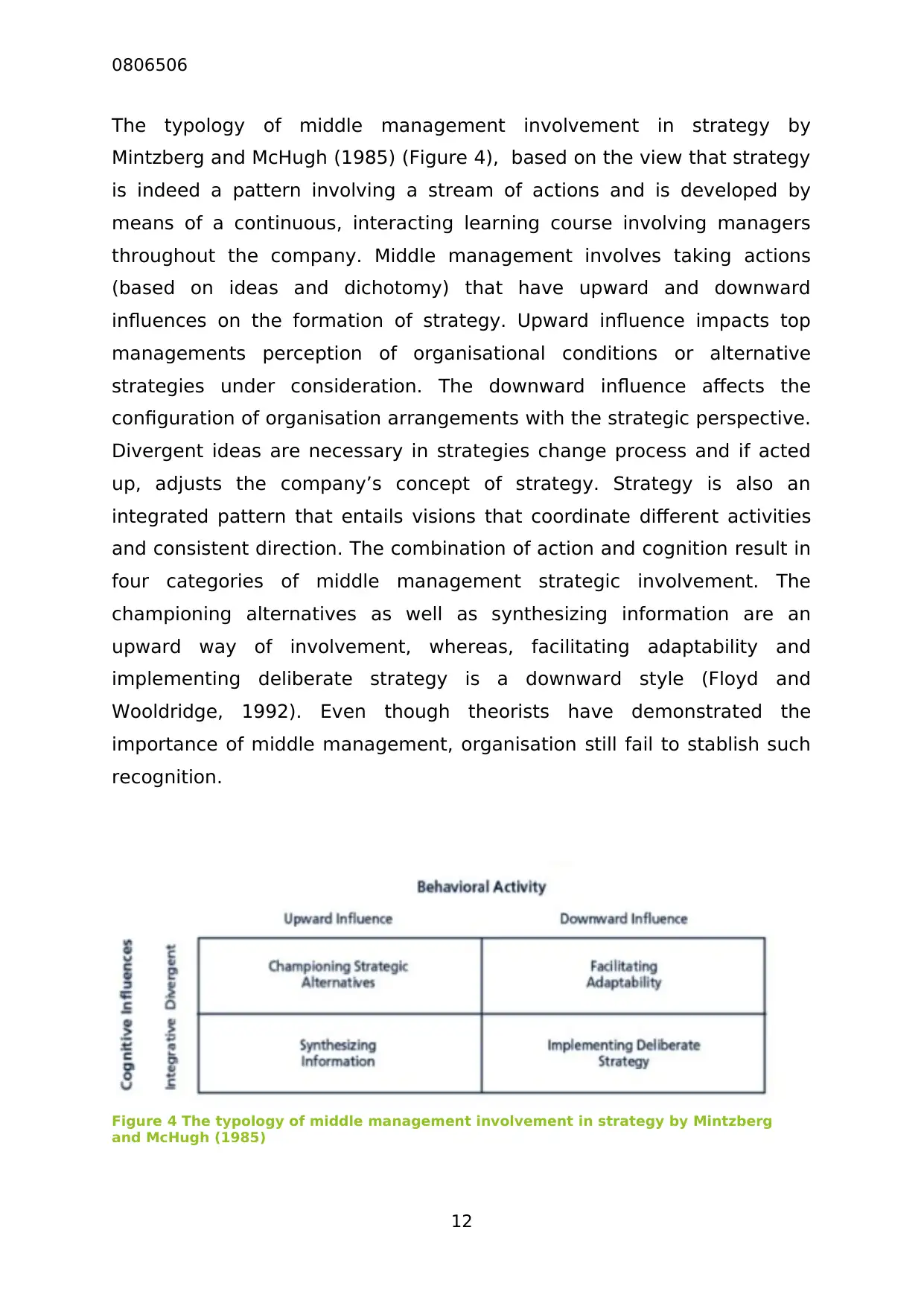
0806506
The typology of middle management involvement in strategy by
Mintzberg and McHugh (1985) (Figure 4), based on the view that strategy
is indeed a pattern involving a stream of actions and is developed by
means of a continuous, interacting learning course involving managers
throughout the company. Middle management involves taking actions
(based on ideas and dichotomy) that have upward and downward
influences on the formation of strategy. Upward influence impacts top
managements perception of organisational conditions or alternative
strategies under consideration. The downward influence affects the
configuration of organisation arrangements with the strategic perspective.
Divergent ideas are necessary in strategies change process and if acted
up, adjusts the company’s concept of strategy. Strategy is also an
integrated pattern that entails visions that coordinate different activities
and consistent direction. The combination of action and cognition result in
four categories of middle management strategic involvement. The
championing alternatives as well as synthesizing information are an
upward way of involvement, whereas, facilitating adaptability and
implementing deliberate strategy is a downward style (Floyd and
Wooldridge, 1992). Even though theorists have demonstrated the
importance of middle management, organisation still fail to stablish such
recognition.
12
Figure 4 The typology of middle management involvement in strategy by Mintzberg
and McHugh (1985)
The typology of middle management involvement in strategy by
Mintzberg and McHugh (1985) (Figure 4), based on the view that strategy
is indeed a pattern involving a stream of actions and is developed by
means of a continuous, interacting learning course involving managers
throughout the company. Middle management involves taking actions
(based on ideas and dichotomy) that have upward and downward
influences on the formation of strategy. Upward influence impacts top
managements perception of organisational conditions or alternative
strategies under consideration. The downward influence affects the
configuration of organisation arrangements with the strategic perspective.
Divergent ideas are necessary in strategies change process and if acted
up, adjusts the company’s concept of strategy. Strategy is also an
integrated pattern that entails visions that coordinate different activities
and consistent direction. The combination of action and cognition result in
four categories of middle management strategic involvement. The
championing alternatives as well as synthesizing information are an
upward way of involvement, whereas, facilitating adaptability and
implementing deliberate strategy is a downward style (Floyd and
Wooldridge, 1992). Even though theorists have demonstrated the
importance of middle management, organisation still fail to stablish such
recognition.
12
Figure 4 The typology of middle management involvement in strategy by Mintzberg
and McHugh (1985)
⊘ This is a preview!⊘
Do you want full access?
Subscribe today to unlock all pages.

Trusted by 1+ million students worldwide
1 out of 31
Related Documents
Your All-in-One AI-Powered Toolkit for Academic Success.
+13062052269
info@desklib.com
Available 24*7 on WhatsApp / Email
![[object Object]](/_next/static/media/star-bottom.7253800d.svg)
Unlock your academic potential
Copyright © 2020–2025 A2Z Services. All Rights Reserved. Developed and managed by ZUCOL.





